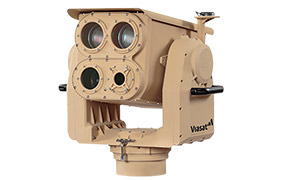R&D Highlights: Space-Time Cloak
Scientists in the UK have developed a method for manipulating the speed of light as it passes over an object, creating a proof-of-concept design for a new type of electromagnetic cloak that conceals events rather than objects.
The group's space-time cloak (STC) makes it theoretically possible to hide an object's movement with metamaterials so that an observer doesn't notice. The space-time cloak, also called a history editor, was reported in the November Journal of Optics.
An Imperial College London team led by Sir John Pendry previously showed that metamaterials could be used to make an optical invisibility cloak by bending light around an object.
Now another team, led by SPIE Fellow Martin McCall from the Department of Physics at Imperial, has mathematically extended the idea of Pendry's cloak to create an undetectable blind spot for events.
"Light normally slows down as it enters a material, but it is theoretically possible to manipulate the light rays so that some parts speed up and others slow down," McCall says. When light is 'opened up' in this way, rather than being curved in space, the leading half of the light speeds up and arrives before an event, while the trailing half lags behind and arrives too late.

Courtesy Imperial College London
The result is that for a brief period, the event is not illuminated and escapes detection. Once the concealed passage has been used, the cloak can then be 'closed' seamlessly.
Such a space-time cloak would open up a temporary corridor through which energy, information, and matter could be manipulated or transported undetected.
"If you had someone moving along the corridor, it would appear to a distant observer as if they had relocated instantaneously, creating the illusion of a Star-Trek transporter," McCall says. "So, theoretically, this person might be able to do something and you wouldn't notice."
While using the space-time cloak to make people move undetected is still science fiction, there are many serious applications for the new research.
Paul Kinsler, one of four authors of the paper, developed the proof-of-concept design using customized optical fibers, which would enable researchers to use the event cloak in signal processing and computing. A given data channel could, for example, be interrupted to perform a priority calculation on a parallel channel during the cloak operation. Afterwards, it would appear to external parts of the circuit as though the original channel had processed information continuously, so as to achieve 'interrupt-without-interrupt.'
 "We're sure that there are many other possibilities opened up by our introduction of the concept of the space-time cloak," McCall says, "but as it's still theoretical at this stage, we still need to work out the concrete details for our proposed applications."
"We're sure that there are many other possibilities opened up by our introduction of the concept of the space-time cloak," McCall says, "but as it's still theoretical at this stage, we still need to work out the concrete details for our proposed applications."
Metamaterials have a vast array of potential applications in defense, security, medicine, data transfer, and computing. Ordinary household devices that work using electromagnetic fields could be made more cheaply or to work at higher speeds. Metamaterials could also be used to control other types of waves as well as light, such as sound or water waves, opening up possible applications for protecting coastal or offshore installations, or even engineering buildings to withstand earthquake waves.
Redacting history by concealing events also has major implications for research in metamaterials, slow light, and phase modulation. Curving light rays in space-time rather than in space sets new challenges for metamaterials design, the authors say. But these challenges can be minimized through "judicious manipulation of the refractive index of the metamedium."
The authors, who include SPIE member Allan Boardman of the University of Salford (UK), acknowledged funding from the Engineering and Physical Sciences Research Council (EPSRC) and the Leverhulme Trust.
Imperial College's Alberto Favaro is one of four UK scientists who have developed a proof-of-principle design for the space-time cloak.
"Imagine computer data moving down a channel to be like a highway full of cars," he explains. "You want to have a pedestrian crossing without interrupting the traffic, so you slow down the cars that haven't reached the crossing, while the cars that are at or beyond the crossing get sped up, which creates a gap in the middle for the pedestrian to cross. Meanwhile an observer down the road would only see a steady stream of traffic."
One issue that cropped up during the group's calculations was to speed up the transmitted data without violating the laws of relativity.
Favaro solved this by devising a material whose properties varied in both space and time, allowing the cloak to be formed.
See an animated video of the space-time invisibility cloak on the Imperial College press release.
Find more news and technical articles on metamaterials and invisibility cloaks on the SPIE Newsroom.
Have a question or comment about this article? Write to us at spieprofessional@spie.org.



